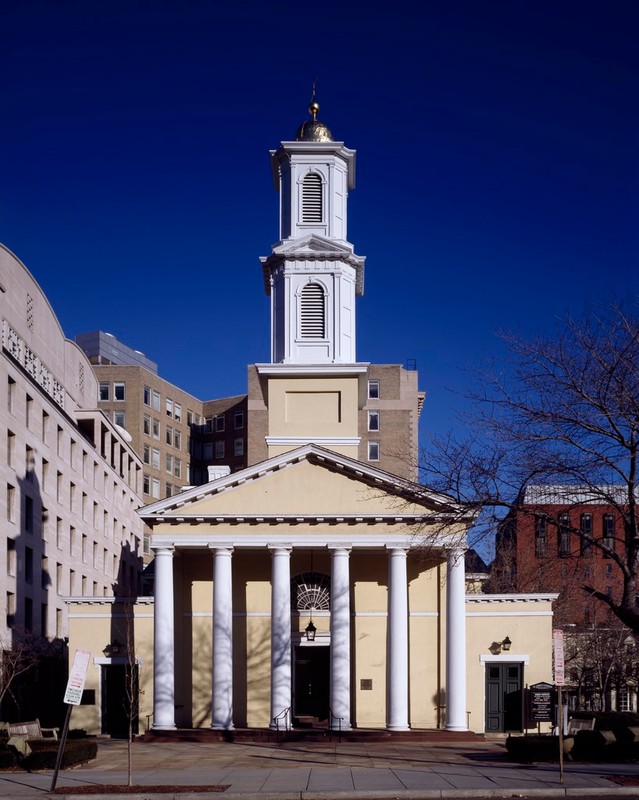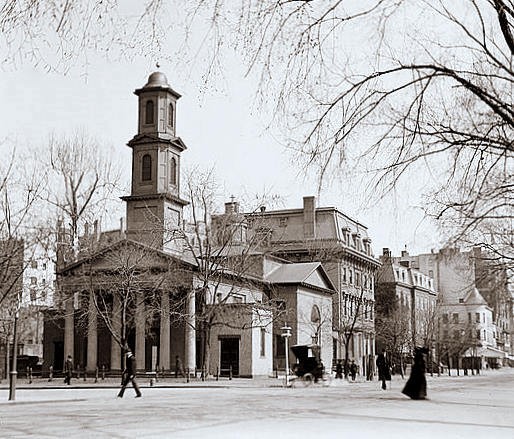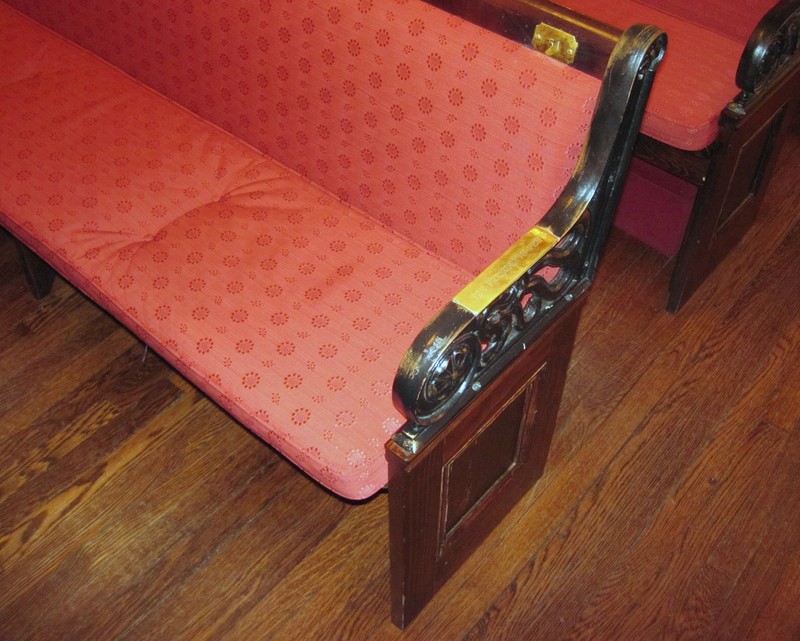St. John's Episcopal Church, Lafayette Square
Introduction
Text-to-speech Audio
Built from 1815 to 1816, St. John's Episcopal Church was the second building to be constructed in Lafayette Square. Known as "the church of the Presidents," every sitting president since James Madison has attended services at St. John's. Notable features of St. Johns include the nearly-1,000 lb steeple bell, cast by Paul Revere's son, and 25 historic stained glass windows, produced by Lorin Stained Glass Windows. The adjacent Parish House is also a National Historic Landmark.
Images
St. John's Church, Washington, D.C.

St. John's Episcopal Church in 1918

The Presidents' Pew, St. John's Episcopal Church, Washington, D.C. Image by Jonathunder - Own work, GFDL 1.2, https://commons.wikimedia.org/w/index.php?curid=20236250

St. John's Church, Washington, D.C.

St. John's Episcopal Church in 1918

The Presidents' Pew, St. John's Episcopal Church, Washington, D.C. Image by Jonathunder - Own work, GFDL 1.2, https://commons.wikimedia.org/w/index.php?curid=20236250

Backstory and Context
Text-to-speech Audio
St. John's Episcopal Church in Lafayette Square, Washington, D.C. is a historic church that has served as an important landmark in the area since construction began in 1815. The church held its first service on October 27, 1816 and was consecrated on December 27, 1816. The building exterior is made from stucco-covered brick in a distinctive yellow color. It was originally designed in the Greek Classical style by Benjamin Latrobe, the architect famous for his work on the Capitol, White House, and Decatur House. Subsequent additions, such as an 1820 extension and the addition of a triple-tiered steeple, have altered the Latrobe's plan, but the original structure remains recognizable.
St. John's has long been known as "the Church of the Presidents," as every sitting president since James Madison has attended services here. Pew 54 is the President's pew, which is reserved for the POTUS when in attendance at the church, a tradition which began with Madison in 1816. In the pew is an 18th-century prayer book featuring the autographs of many of the Presidents.
St. John's also has strong ties with the African American community. The second Rector of St. John's, Reverend William Hawley, baptized and married African Americans of all legal statuses during his leadership of the Church from 1817 to 1845. In the late 1860s, the Rector of St. John's worked with a group of 28 African Americans to establish Mary's Chapel for Colored People in Foggy Bottom. During the 1963 March on Washington for Jobs and Freedom, St. John's rector—Rev. John C. Harper—held a special service of prayer open to all races; the event was attended by 700 congregants.
Notable features of the church includes the nearly-1,000 lb steeple bell cast by Joseph Revere at his Boston foundry in 1822. It is one of two Revere bells in Washington, and the only one to remain in continuous service since its installation. St. John's is also famous for its 25 stained glass windows, which were designed and produced by the Lorin Stained Glass Windows firm of Chartres, France in 1883. Inside St. Johns are a number of works of art. These include two sculptures by Jay Hall Carpenter, a brass chapel cross, and Ascent Into Heaven, a 3/4 lifesize bronze sculpture. Amongst its other treasures are a silver chalice and a gold, jewel-encrusted communion chalice.
St. John's Episcopal Church was added to the National Register of Historic Places in 1966 and has been a National Historical Landmark since 1960. Today, the church continues to conduct regular services and serve the D.C. community. Tours are available after most Sunday services and also by reservation. Adjacent to the church is another well-known historical landmark in Lafayette Square, the Ashburton House, which now serves as St. John's Parish House.
St. John's has long been known as "the Church of the Presidents," as every sitting president since James Madison has attended services here. Pew 54 is the President's pew, which is reserved for the POTUS when in attendance at the church, a tradition which began with Madison in 1816. In the pew is an 18th-century prayer book featuring the autographs of many of the Presidents.
St. John's also has strong ties with the African American community. The second Rector of St. John's, Reverend William Hawley, baptized and married African Americans of all legal statuses during his leadership of the Church from 1817 to 1845. In the late 1860s, the Rector of St. John's worked with a group of 28 African Americans to establish Mary's Chapel for Colored People in Foggy Bottom. During the 1963 March on Washington for Jobs and Freedom, St. John's rector—Rev. John C. Harper—held a special service of prayer open to all races; the event was attended by 700 congregants.
Notable features of the church includes the nearly-1,000 lb steeple bell cast by Joseph Revere at his Boston foundry in 1822. It is one of two Revere bells in Washington, and the only one to remain in continuous service since its installation. St. John's is also famous for its 25 stained glass windows, which were designed and produced by the Lorin Stained Glass Windows firm of Chartres, France in 1883. Inside St. Johns are a number of works of art. These include two sculptures by Jay Hall Carpenter, a brass chapel cross, and Ascent Into Heaven, a 3/4 lifesize bronze sculpture. Amongst its other treasures are a silver chalice and a gold, jewel-encrusted communion chalice.
St. John's Episcopal Church was added to the National Register of Historic Places in 1966 and has been a National Historical Landmark since 1960. Today, the church continues to conduct regular services and serve the D.C. community. Tours are available after most Sunday services and also by reservation. Adjacent to the church is another well-known historical landmark in Lafayette Square, the Ashburton House, which now serves as St. John's Parish House.
Sources
"History – St. John's Church." St. John's Church. Accessed November 16, 2016. https://stjohns-dc.org/welcome-to-saint-johns-church/history/.
"St. John's Church - White House Historical Association." WHHA. Accessed November 16, 2016. https://www.whitehousehistory.org/st-johns-church.
"St. John's Episcopal Church, Lafayette Square." Wikipedia, the Free Encyclopedia. Accessed November 16, 2016. https://en.wikipedia.org/wiki/St._John%27s_Episcopal_Church,_Lafayette_Square.
"St. John's." NPS.gov (U.S. National Park Service). Accessed November 16, 2016. https://www.nps.gov/nr/travel/wash/dc28.htm.
"St. John's Church - White House Historical Association." WHHA. Accessed November 16, 2016. https://www.whitehousehistory.org/st-johns-church.
"St. John's Episcopal Church, Lafayette Square." Wikipedia, the Free Encyclopedia. Accessed November 16, 2016. https://en.wikipedia.org/wiki/St._John%27s_Episcopal_Church,_Lafayette_Square.
"St. John's." NPS.gov (U.S. National Park Service). Accessed November 16, 2016. https://www.nps.gov/nr/travel/wash/dc28.htm.
